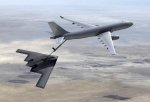Karthick Ashwath
Junior Member
Hey guys, I believe its time for another exciting and difficult flitetest challenge!(been a while since you did a viewer request challenge)
Outline:
The target is to build an aerial refuelling aircraft which can refuel/recharge a fleet of 1-3 small fighters.(fairly small, maybe 20" wingspan maximum?)(doesn't have to be fast)
Rules/Guidelines:
1.The aerial refueller can be anything(plane/helicopter/blimp etc.)
2.The aerial refueller can use any power source(lipo,li-ion,solar PV,solar thermal,gas,etc.)
3.The refueller does not need to have the capacity to allow fighter planes to land and recharge on it.(airdeck is optional)
4.The fighters must be electric.They don't have to be fast at all.In fact, they can even be a highly efficient motorglider.
5.All the planes must be in the air throughout the operation.They are not allowed to land on the ground.
6.A safe fast charging to 80% of capacity is enough.(balance charging not needed)
7.You can choose how many aircraft you want to refuel/recharge at a time.
8. You can go for a robotic fully controlled boom or a free flying hose/wire/small quadcopter(like a tiny whoop) with magnetic contacts to attach on metal plates on the plane or anything else. Mode of refuelling is upto you.
9.(edit)You may use supercapacitors to greatly reduce the charging time.
By using a supercapacitor, you can greatly reduce the charging time, but this will cause the flying time to come down and will also require proper circuitry to be charged safely.Use a microcontroller(like the arduino) to check that the proper polarity is received and start charging only after that(there is a chance that the wrong terminals on the charging side get attached)
10.(edit)You may use hooks/rails to keep the fighters in the air.
If the rules are too difficult please do tell me!


Warm regards,
Karthick Ashwath.
Outline:
The target is to build an aerial refuelling aircraft which can refuel/recharge a fleet of 1-3 small fighters.(fairly small, maybe 20" wingspan maximum?)(doesn't have to be fast)
Rules/Guidelines:
1.The aerial refueller can be anything(plane/helicopter/blimp etc.)
2.The aerial refueller can use any power source(lipo,li-ion,solar PV,solar thermal,gas,etc.)
3.The refueller does not need to have the capacity to allow fighter planes to land and recharge on it.(airdeck is optional)
4.The fighters must be electric.They don't have to be fast at all.In fact, they can even be a highly efficient motorglider.
5.All the planes must be in the air throughout the operation.They are not allowed to land on the ground.
6.A safe fast charging to 80% of capacity is enough.(balance charging not needed)
7.You can choose how many aircraft you want to refuel/recharge at a time.
8. You can go for a robotic fully controlled boom or a free flying hose/wire/small quadcopter(like a tiny whoop) with magnetic contacts to attach on metal plates on the plane or anything else. Mode of refuelling is upto you.
9.(edit)You may use supercapacitors to greatly reduce the charging time.
By using a supercapacitor, you can greatly reduce the charging time, but this will cause the flying time to come down and will also require proper circuitry to be charged safely.Use a microcontroller(like the arduino) to check that the proper polarity is received and start charging only after that(there is a chance that the wrong terminals on the charging side get attached)
10.(edit)You may use hooks/rails to keep the fighters in the air.
If the rules are too difficult please do tell me!


Warm regards,
Karthick Ashwath.
Last edited:

